Yaupon, A Native American Tea
“What’s in a name? That which we call a rose,
By any other word would smell as sweet.”William Shakespeare, Romeo and Juliet v. Q2 1599
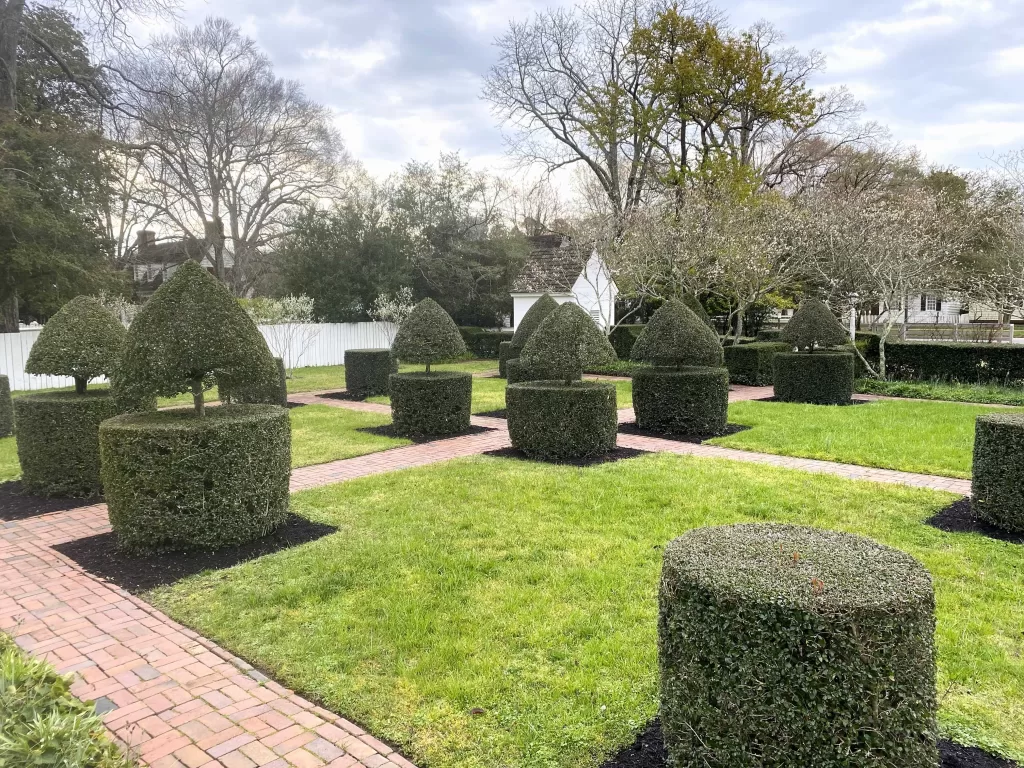
Yaupon holly shrubs are trimmed into formal topiaries at Colonial Williamsburg. Photo Courtesy of Rick Brown, March 2024
What is in a name? How does naming a thing affect its destiny and how later generations will view it? The story of how a popular native holly came by its name, and how that name destroyed a promising Colonial American industry, demonstrates that names have incredible power to shape the future.
Yaupon Tea in Pre-Colonial America
Native Americans living from coastal Virginia south to Florida, westwards across the Gulf Coast to Texas, and northwards into the interior of the continent enjoyed a soothing, medicinal beverage made from the roasted leaves of the yaupon holly shrub. A survey of historical reports and the work of ethnographers compiled by Dr. William L. Merrill, and published in Charles Hudson’s Black Drink A Native American Tea, demonstrates that use of the beverage varied from community to community and was not observed in all parts of this territory. The practice of drinking tea was so well established, however, and so consistent over such a large area, that anthropologists believe Native Americans were enjoying their tea for more than a thousand years before Europeans came to North America.
The Botany of Yaupon Holly
Yaupon is an evergreen holly, providing habitat for birds and landscape structure year-round. Its leaves are thick and glossy, smooth edged and oval, without the prickles normally found on holly leaves. They vary in size, depending on cultivar, from an inch to as much as 3” long, and up to an inch wide. They emerge alternately on the branch. Yaupon bark is smooth, thin, and nearly white.
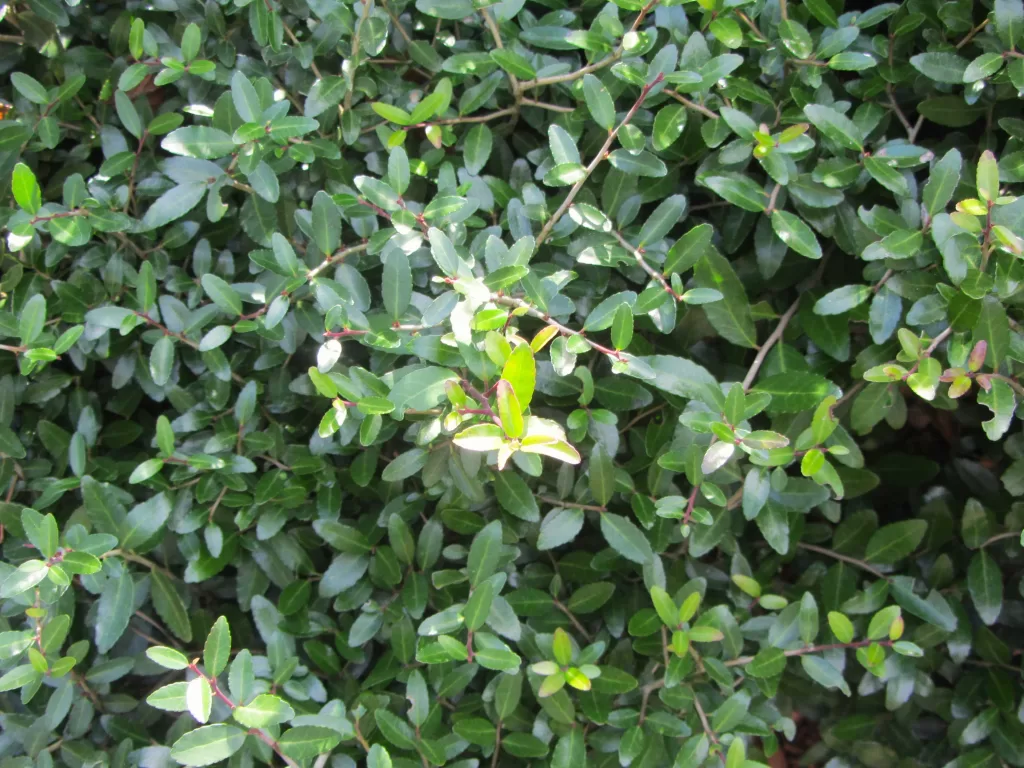
Leaves of Ilex vomitoria ‘Schillings Dwarf’ in early March 2024. Photo by E. L. McCoy
Yaupon holly grows in sand, loam, or clay in full sun to deep shade in Zones 7-9, as far north as Maryland on the Chesapeake Bay and the Atlantic Coast. It withstands salt spray on barrier islands, grows well in sweet or acidic soil, and yaupon can survive occasional flooding or drought. It is resistant to Phytophthora root rot. Deer rarely touch it, and so it is a dependable shrub to plant in areas where deer, rabbits, and other wildlife roam into yards.
There is great variation in the growth habit of yaupon holly. It can grow in large, multi-stemmed thickets to over 20 feet tall and wide, covering large expanses of ground. One of the taller varieties is weeping. There are smaller selections that grow to only 4’-6’ tall, and even smaller shrubs that grow to 18” or lower, like woody groundcovers. The smaller varieties grow in neat, round forms and can be used to replace boxwood in more formal landscapes. Yaupon holly can be sheared into formal hedges and topiaries. A wide variety of named cultivars and selections of yaupon holly are available on the market to suit a variety of landscape needs.
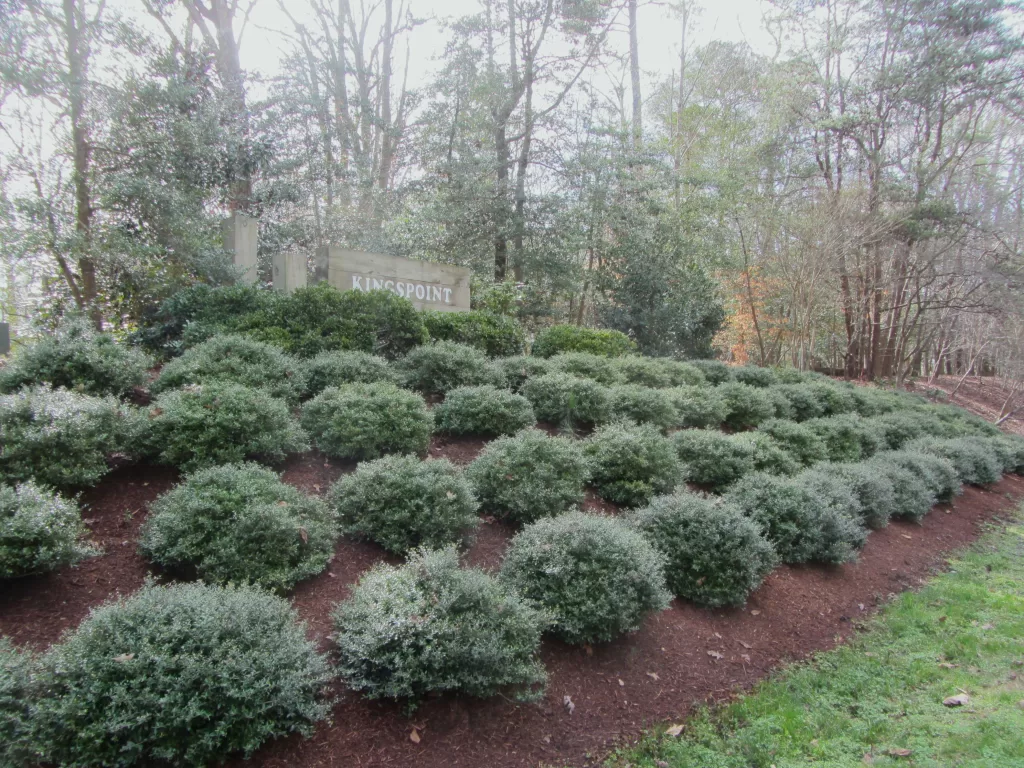
I. vomitoria ‘Schillings Dwarf’ were planted at the Kingspoint neighborhood entrance in 2016 and have not been pruned since. This is a very slow growing male cultivar. Photo by E. L. McCoy March 2024
All hollies are dioecious, with only female plants producing berries. But each stand of female plants needs one or more male plants as pollinators. Yaupon holly is known for abundant clusters of red berries beloved by birds, and they support pollinators, including specialized native bees, in spring. Yaupon holly is the larval host for the Henry’s Elfin, and Holly Azure butterfly.
A Native American Heritage
The common name, yaupon, comes from the Catawban language, spoken by the Catawba people living in the Carolina and Virginia. The Catawba people worked with colonists on many occasions and entered into treaties with European settlers throughout the 18th and 19th centuries. They fought in the Revolutionary War alongside the colonists and with the Confederates during the Civil War. They were one of several native American groups to share ‘black drink,’ or cassina, with Europeans.
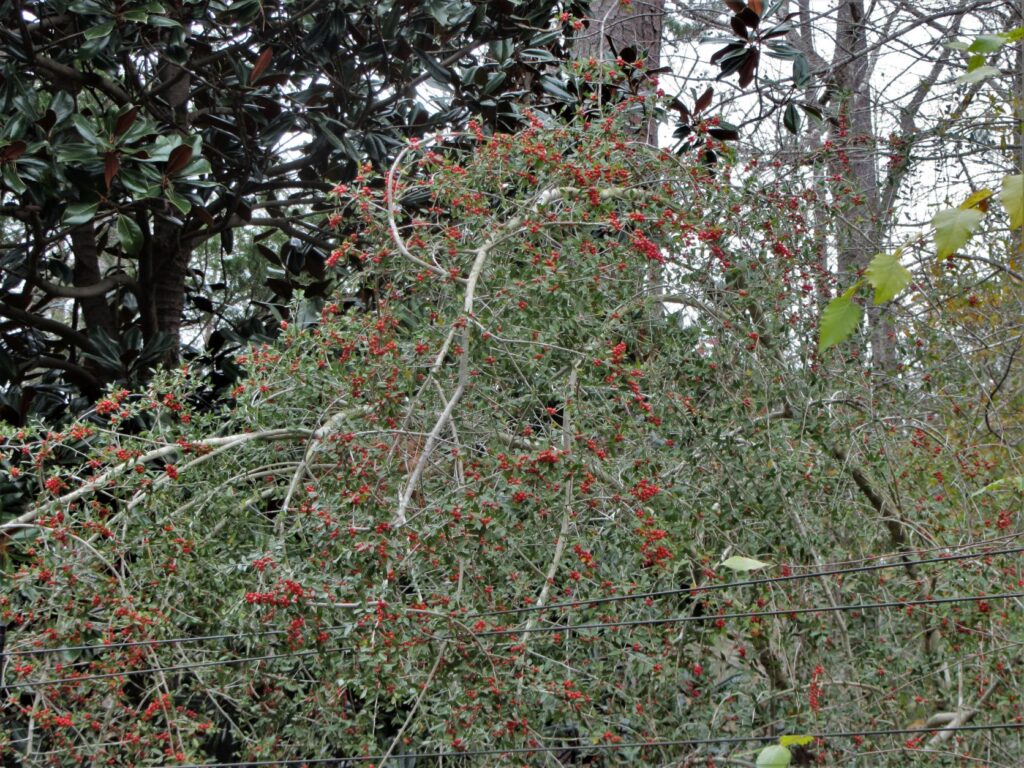
I. vomitoria, ‘Pendula’ (F), or weeping yaupon, produces abundant berries each year at the Williamsburg Botanical Garden and Freedom Park Arboretum. A male I. vomitoria ‘Pendula’ grows nearby. Photo by E. L. McCoy December 2020
The Spanish first encountered this native beverage in Florida in the early 16th century. Nunez Cabeca de Vaca writes about Cassine vera Floridanorum (yaupon) in 1542. This native tea is mentioned in various written accounts of explorers over the next two centuries, including John Locke asking a ship’s captain to locate cassini in 1671. Cassine is listed as one of the varieties of useful plants located in the New World in the 1700 edition of Leonard Plukenett’s “Almagesti Botanici Mantissa” published in London. John Lawson mentions cassina, or Indian tea, again in his 1709 “A New Voyage to Carolina,’ also published in London, and provides a description of its preparation:
“ They take this plant, (not only the leaves, but the smaller twigs along with them) and bruise it in a mortar, till it becomes blackish, the Leaf being wholly defaced: Then the take it out, put it into one of their earthen Pots which is over the Fire, till it smokes; stirring it all the time till it is cur’d. Others take it, after it is bruis’d, and put it into a Bowl to which they put live Coals, and cover them with the Yaupon, until they have done smoaking, often turning them over. After all, they spread it upon their Mats, and dry it in the Sun, to keep for use.”
Native Americans prepared yaupon tea for their own use in this manner, but also as a product for trade. It was used widely among native groups in the Southeast and along the Mississippi River for various purposes. Some used it as a daily beverage, much as we drink coffee or tea made from the leaves of Camellia sinensis, because yaupon holly leaves also contain caffeine. Yaupon tea was sipped to soothe, to heal, and to help maintain alertness. It contains theobromine, also found in tea and in cocoa. The alkaloid theobromine translates from the Greek as ‘food of the gods.’

This female weeping yaupon was so top heavy that it fell over in a storm. Tree Stewards and WBG Volunteers Harry Fahl and Bill Dichtel saved it by staking it upright. The male shrub was as tall or taller than this one, but was not as exposed to the wind and survived upright. Photo by E. L. McCoy December 2020
Medicinal Uses of Yaupon Tea
Yaupon was also used medicinally to maintain good health, sometimes taken in larger quantities every other day for its cleansing properties as a diuretic and emetic. It is high in antioxidants. Native people living in the Southeast were subject to certain ailments brought on by the dampness and weather and believed that the tea’s diuretic powers helped them avoid these illnesses. It was used to help prevent kidney stones.
The Social Uses of Yaupon Tea
Native Americans routinely served cassina during diplomatic meetings between tribal leaders and between tribal leaders and Europeans. Serving black drink was a social signal of acceptance and friendship. Some native groups ritually drank black drink before battles and before sporting competitions between tribes. The tribal leader was always served first. He poured some on the ground as a sacrifice and gave thanks before drinking. After he began to drink his companions drank as well.
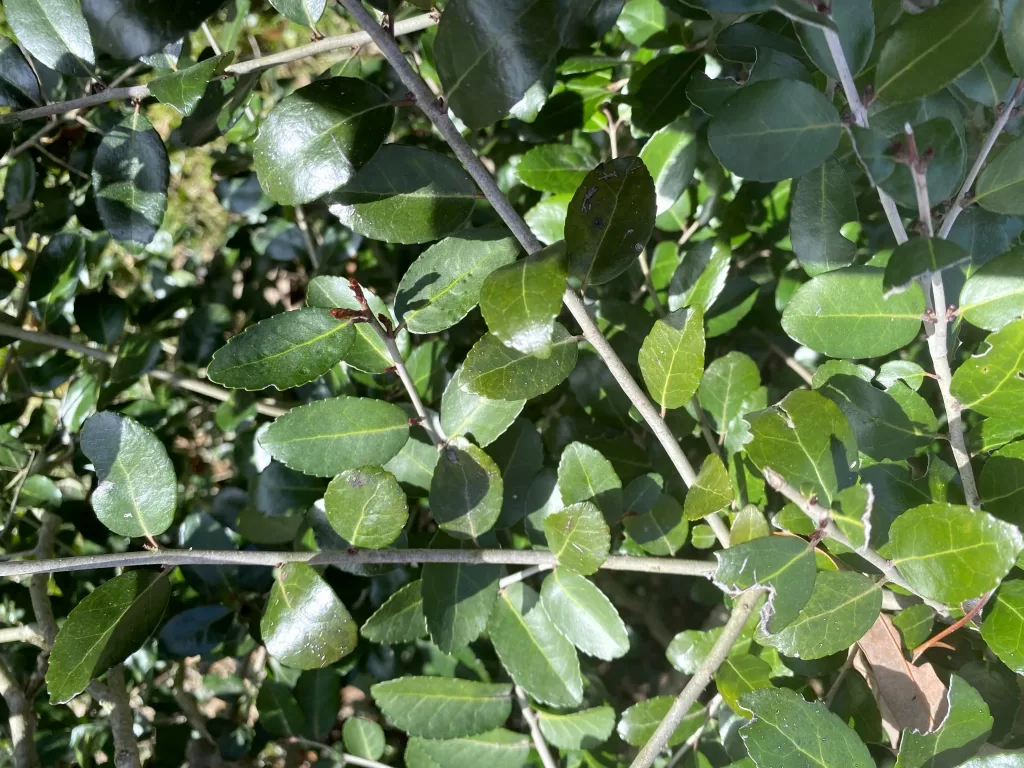
Yaupon holly leaves on the shrubs used for topiaries at Colonial Williamsburg. Photo Courtesy of Rick Brown, March 2024
Most accounts indicate that freshly roasted yaupon holly leaves were added to boiling water to brew the black drink. The proportion of tea to water and length of time the leaves were boiled varied depending on how the tea would be used. In some cultures, the tea was stirred with a specially fashioned gourd to create frothy foam on top of the beverage as it was served. The finished tea was cooled only enough to safely drink. Caffeine is water soluble and at its strongest when the tea is consumed hot.
This black drink, or yaupon tea, was consumed formally by the high-ranking men of native American communities in most reported cases. Women, low ranking men, and children could be present as the community’s leaders drank tea together and discussed community business, but they were not served. An exception seems to be some native groups in present day Texas who served the tea to women, especially for healing.
The yaupon tea was usually served in large, specially fashioned seashells. Archeologists frequently found lightning whelk, horse conch, and emperor helmet shells, common along the coast of Florida and the Gulf of Mexico, made into the drinking vessels uncovered in burials. The shells had the central columella removed and the lip and interior of the shell polished to make a long, dipper-like cup. These shells were traded inland to other native communities. Europeans witnessed native Americans drinking from these cups and recorded the in their accounts. Pottery cups were also used by some groups to consume their cassina.

The shrubs comprising this hedge maze in the Governor’s Palace Gardens are all Yaupon holly. Photo Courtesy of Rick Brown, March 2024
Black Drink, a Valuable Commodity for Trade
Yaupon holly grows mostly in coastal areas, but archeologists have found traces of it in drinking vessels in Cahokia, near St. Louis, Missouri. The vessels dated to between 1050 and 1250 CE, and the insides were coated with the same theobromine, caffeine, and ursolic acid in the correct proportions to have come from yaupon holly. Pottery samples recovered in the Southwestern United States and Northern Mexico also contain these same residues.
There is also some historical evidence that native Americans transplanted yaupon holly shrubs from coastal areas to interior areas so they could grow their own supply of leaves closer to their home territory. Ethnobotanists are still trying to determine whether the yaupon holly shrubs grown inland had the same amount of caffeine and other active ingredients as those grown on the coast.
European Colonists Discover the Delights of Cassina, or Yaupon Tea
Spanish colonists in central Florida were using cacina or té del indio as part of their daily routine by 1615, and reported experiencing symptoms that we would recognize as caffeine dependence. English colonists in the Carolinas quickly learned to harvest yaupon holly leaves and prepare them to brew cassina, or Carolina tea, by the early 18th century. English writers described it as black drink, Indian tea, Appalachian tea, Carolina tea, or cassina.
Use of this native tea increased so that by the late 1700s it was already a more common breakfast beverage in the southeastern colonies than Chinese tea. Because it was cheaper and easier to come by, Yaupon tea remained a common beverage through the Civil War era and into the late 19th century. It was still served in a restaurant on Ocracoke Island as late as the 1970s. By the early 20th century, many Americans living in coastal areas stopped using yaupon tea because it was considered a low status beverage and because commercial tea and coffee were affordable and readily available.
Mark Catesby’s 1754 “The Natural History of Carolina, Florida, and the Bahamas, etc. Volume II,” published in London, accurately describes Cassena vera Floridanorum and illustrates the entry with an accurate colored plate. Catesby mentions that while in South Carolina the tree is known as Cassena, in North Carolina and Virginia it is known as Yaupon. He also observes that colonists regularly drank this native tea. Mariners trading between the colonies, the islands, and Europe also used Yaupon tea to fight scurvy and remain alert while at sea.

Yaupon holly shrubs grow in the John Blair House Gardens on Duke of Gloucester Street in Colonial Williamsburg. English colonists not only learned to enjoy a cup of yaupon tea, they also used yaupon holly shrubs in their gardens and for hedging. Photo Courtesy of Rick Brown, March 2024
The Colonial Tea Trade
Colonists living in coastal areas began to grow and prepare yaupon tea for export to Europe, where it was sold as ‘Carolina Tea,’ ‘Indian Tea,’ or ‘Appalachina Tea.’ The Apalachee Indians of Florida were known for their consumption of black drink, which in French was known as the des Apalaches or Apalachine. It was a colonial novelty, but also a beverage Europeans enjoyed. The export business remained successful, and yaupon holly plants were exported to Europe, where they thrived. Colonists produced and exported this ‘Indian’ or ‘Carolina’ tea until the 1780s.
By 1774, after the Boston Tea Party, colonists increasingly relied on a variety of herbal ‘teas,’ known as ‘tisanes,’ as a substitute for the Chinese tea so heavily taxed by the British government. Of course, they relied on the native yaupon tea and southern colonies traded it to those colonies north of yaupon holly’s range. The British were disturbed that sales of taxed, Asian tea plummeted in the years leading up to the Revolution.

Dahoon holly is another native holly that is easily confused with yaupon holly. But its leaves don’t contain caffeine or other phytochemicals found in yaupon holly. The central shrub in this garden at the William Bryant House in Colonial Williamsburg is dahoon holly. Photo Courtesy of Rick Brown, March 2024
Black Drink’s Use for Ritual Purification in Native American Culture
But it was the very specialized, Native American ritual use of the black drink which caught the Europeans’ attention and eventually led to its fateful name. Native Americans, mostly the men, brewed a very strong version of the yaupon tea, and then drank it in large quantities, to cleanse themselves before participating in certain rituals. They drank large enough quantities of the strong tea to make themselves vomit publicly, thus ritually cleansing themselves. Most native groups had strong taboos concerning what to eat, who to interact with, and how to maintain purity. The warriors and tribal leaders drank and vomited in tribal councils, before war, and before their shamanic healing and other ritual activities.
This was very unusual to European observers. They had already observed that Native Americans prepared yaupon holly leaves in different ways to produce different strengths and variations of the tea for different purposes. Used on their own, yaupon leaves are not an emetic. Some contemporary observers, as well as anthropologists and botanists, suspected that other plants, like rattlesnake master, Eryngium yuccifolium, or even salty ocean water, may have been added to the yaupon to produce the ritual emetic beverage. We don’t know all of the details of how the ritual black drink was prepared, yet colonial era Europeans still observed native Americans using the tea on some occasions as a digestive cleanser.

Dahoon holly, center, at the William Bryant House Garden on Duke of Gloucester Street in Colonial Williamsburg. The hedges in this garden are boxwood. Yaupon holly is a good substitutes for European box because it isn’t susceptible to boxwood blight. Photo Courtesy of Rick Brown, March 2024
The Chemistry of Yaupon Holly
Researchers who analyzed yaupon leaves, and the tea made from them in 2002, determined that yaupon leaves contain less caffeine than coffee beans by weight. Another group of researchers in 2005 determined that the only potentially toxic compound in Yaupon was theobromine, but there is significantly less concentrated in yaupon than in cocoa.
The North Carolina Extension Gardener Plant Toolbox website still describes yaupon holly as slightly toxic because of its fruits, which can cause nausea, vomiting, and diarrhea. But it is well known that all holly berries are considered poisonous to humans.
Binomial nomenclature came into common use in 1753 with Carl Linnaeus’s Species Plantarum. Under this new system for naming organisms, each is given a genus name and a species name, both of which are latinized. And this is where things get interesting with the botanical name of this useful plant. The name Ilex cassine was used in some instances, including in the printed works of Dr. Johann D. Schoepf in 1783-84 and again in1787. Carl Linnaeus mistakenly included two different Ilex species under his original name of Ilex Cassine vera Floridanorum in 1753. There was yaupon holly, but also the newly discovered and more tender dahoon holly, which has no caffeine and was never used to produce a beverage.
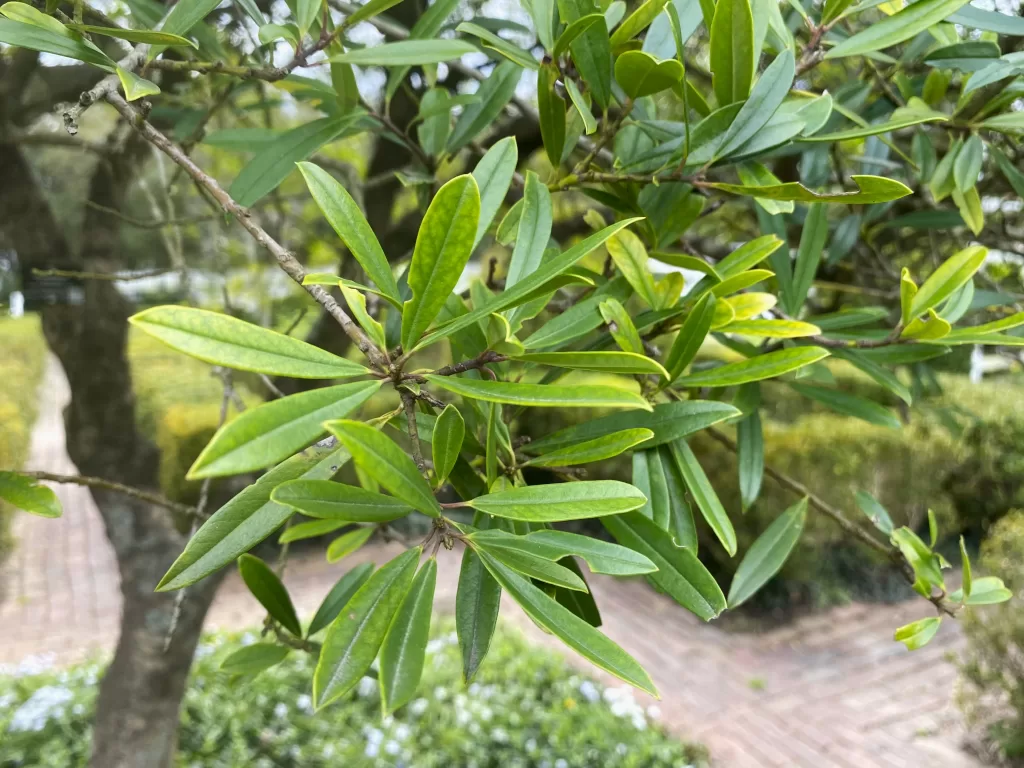
Dahoon holly leaves are longer and of a different texture than yaupon holly leaves. Close-up of the leaves for comparison to Yaupon. Photo Courtesy of Rick Brown, March 2024
The Importance of Names
In 1789, English botanist William Aiton, a royal gardener working as Director of Kew Royal Botanical Gardens and personal friend of King George, renamed our native yaupon holly Ilex vomitoria. He left dahoon holly with the name Ilex cassine. This very descriptive name seriously dampened enthusiasm for the less expensive, traditional American beverage made from yaupon, or Ilex vomitoria leaves. It nearly eliminated trade for yaupon tea and refocused European tastes on Asian tea made from the Camellia sinensis plant.
Given the past colonial concerns with the British proclivity to impose restrictive taxes on imported Asian teas without benefit of representation, and the subsequent defeat of King George’s army at Yorktown just eight years prior, we are left to speculate whether the 1789 publication of the name change to I. vomitoria was a petty and spiteful attempt by Aiton, on behalf of his friend, ‘Mad King George,’ to seriously damage the American tea industry once and for all. Nevertheless, the acknowledged true beneficiaries of the renaming efforts were the East India Company, which held a near monopoly on teas imported by England to her rebellious former colonies.
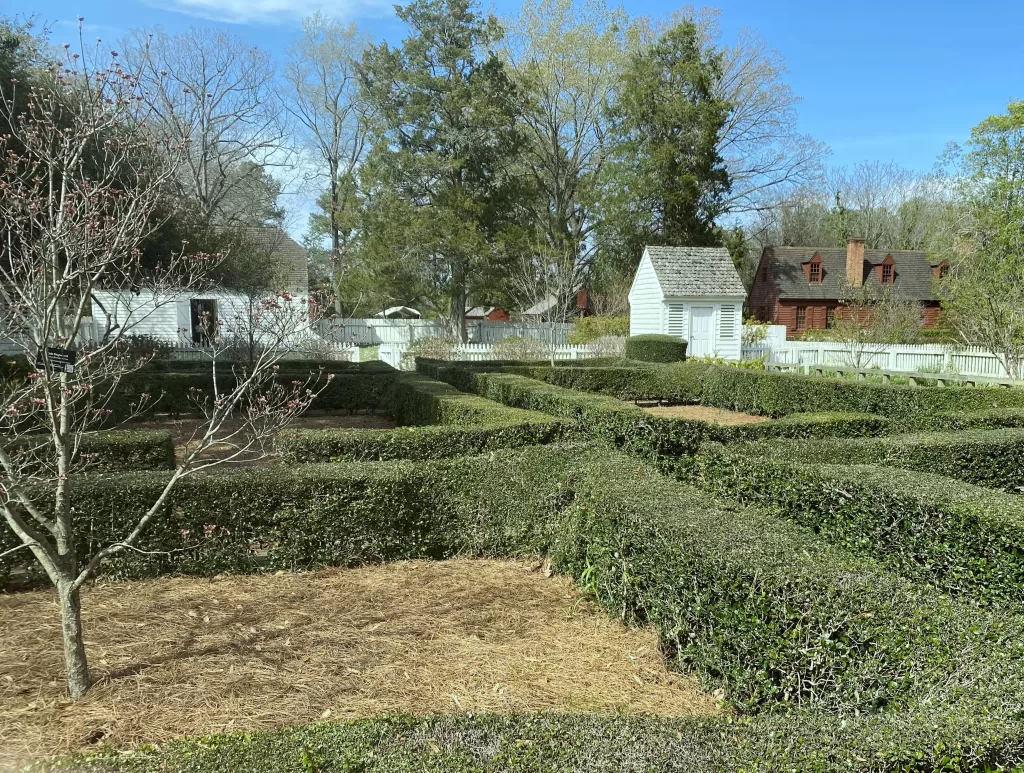
Sculptured hedges of yaupon holly at the Prentis House Garden on Duke of Gloucester Street frame the garden. Hedges like these can be pruned regularly to process the leaves into tea. Photo Courtesy of Rick Brown, March 2024
Yaupon Holly Tea Today
Yaupon tea remains easy to make at home from the native yaupon holly shrub that grows throughout our area. Leaves contain the most caffeine and have the best flavor in spring and early summer but can be harvested year-round. Leaves should be rolled and bruised, as for tea made with C. sinensis, and then roasted in an oven or cast iron skillet. After roasting, they should be laid out to cool and dry. Once dry, they are ready for brewing. Some commercial tea companies shred or grind the leaves, much like Asian tea is prepared for sale.
While its scientific name is an interesting story of misnaming all to itself, it isn’t true that drinking cassina, or yaupon tea, will cause one to vomit unless one drinks a huge quantity of very strongly brewed tea. It has many health benefits and is an economical, and ecologically aware alternative to commercial imported teas and coffee.
Native, organically grown yaupon tree is making a resurgence as entrepreneurs grow, process and market an interesting selection of teas, all made from the yaupon holly shrub. This is sustainable agriculture at its best since a single shrub will produce leaves for harvest over many decades. While yaupon tea went out of fashion for a time, it is just as tasty and healthful as ever. It has been grown and enjoyed in the Southeastern United States for thousands of years, and still grows here to quench our thirst today.

Yaupon holly shrubs grow as hedges and topiaries at the Colonial Williamsburg Governor’s Palace. Photo Courtesy of Rick Brown, March 2024
With appreciation to Master Naturalist and Tree Steward Rick Brown, who provided photos for this article, convinced me that yaupon tea isn’t poisonous, and pointed out the rabbit holes I needed to explore to learn its history. All of the trees and shrubs featured in photos taken at Colonial Williamsburg are part of the Colonial Williamsburg Arboretum.
For More Information:
Dirr, Michael A. Dirr’s Encyclopedia of Trees and Shrubs. Timber Press. 2011.
Dirr, Michael A and Keith S. Warren. The Tree Book: Superior Selections for Landscapes, Streetscapes, and Gardens. Timber Press. 2019.
Dutton, Joan Parry. Plants of Colonial Williamsburg – How to Identify 200 of Colonial America’s Flowers, Herbs and Trees. The Colonial Williamsburg Foundation. 1979.
Hudson, Charles M. (editor). Black Drink, a Native American Tea. The University of Georgia Press. 1979.
Joshua (?)“Restoring the Ilex cassine (Walter) name to the plant that was “Cassine, Asi Lupubski, Cassena, Yaupon” and held sacred to the Indigenous tribes of the Southeastern United States. Part 1.” Hortfire.com. December 2016. Accessed March 2024. https://hortfire.com/2016/12/06/restoring-the-ilex-cassine-walter-name-to-the-plant-that-was-cassine-asi-lupubski-cassena-yaupon-and-held-sacred-to-the-indigenous-tribes-of-the-southeastern-united-states-part-1/
Mellichamp, Larry and Will Stuart. Native Plants of the Southeast. Timber Press. 2014.
Richmond, Ben. “The Forgotten Drink That Caffeinated North America for Centuries.” Atlas Obscura. March 28, 2018. Accessed March 2024. https://www.atlasobscura.com/articles/what-is-yaupon-tea-cassina
Steele, Mark. “Yaupon Holly: A Tale of Tea, Sugar, Slavery and Slander.” Yaupon Brothers American Tea Company. June 2020. Accessed March 2024. https://yauponbrothers.com/blogs/news/yaupon-holly-a-tale-of-tea-sugar-slavery-and-slander
Wulf, Andrea. The Brother Gardeners: A Generation of Gentlemen Naturalists and the Birth of an Obsession. Vintage Books. 2010.
